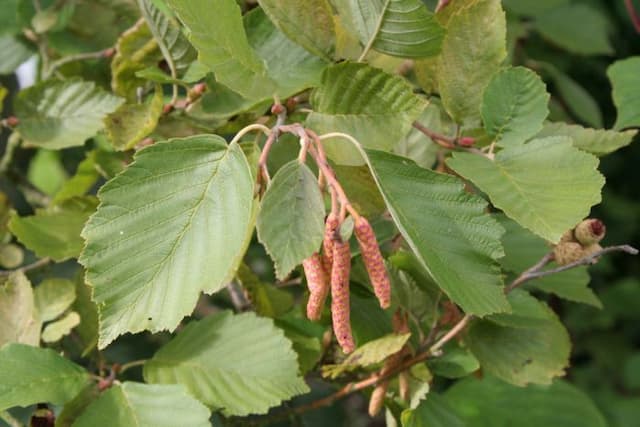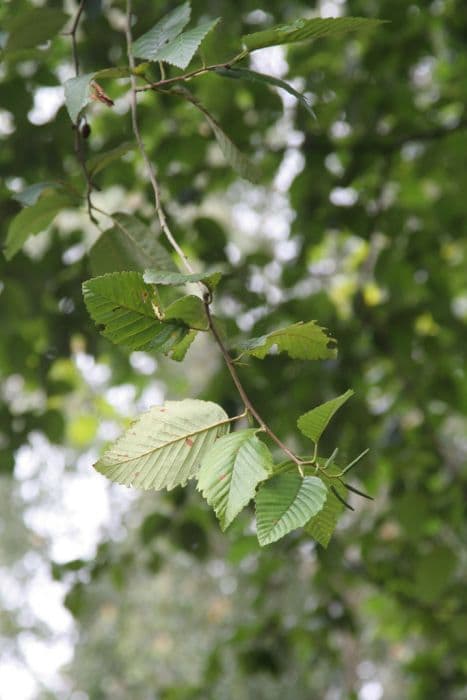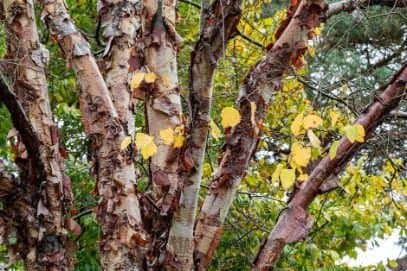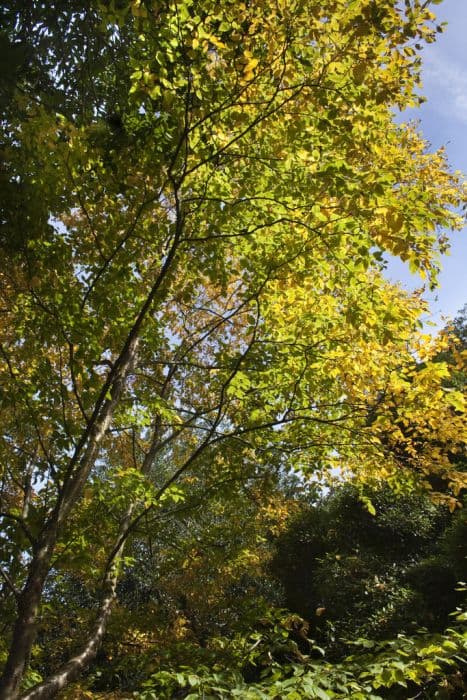Silver Birch Betula pendula

ABOUT
The European white birch, known for its distinctive and elegant appearance, is a species that can easily be recognized by its white, papery bark, which often peels off in horizontal strips. The trunk of the birch is slender and often has dark, diamond-shaped marks or lenticels. The graceful branches of the European white birch are pendulous, hanging down in a weeping form that lends a delicate texture to the landscape. The leaves of the European white birch are small and somewhat triangular in shape with a pointed tip and a rounded base. They are arranged alternately along the branches, and their edges are doubly serrated, giving them a fine, saw-like appearance. During the growing season, the leaves are a vibrant green color that turns into striking hues of yellow in the fall, providing a showy display before they drop. In early spring, the European white birch produces catkins, which are long, cylindrical flower clusters. These catkins dangle from the branches and add to the ornamental value of the tree. The male catkins are longer than the female ones, and after pollination, the female catkins develop small winged seeds that are dispersed by the wind. Overall, the European white birch is a visually stunning tree that adds beauty and character to any setting with its white bark, weeping branch structure, finely toothed green leaves, and decorative catkins.
About this plant
 Names
NamesFamily
Betulaceae
Synonyms
Silver Birch, European White Birch, Warty Birch, East Asian White Birch
Common names
Betula alba, Betula verrucosa, Betula verrucosa var. carpatica, Betula carpatica, Betula pendula var. pendula, Betula pendula var. carelica, Betula fontqueri, Betula talassica, Betula litwinowii, Betula aetnensis.
 Toxicity
ToxicityTo humans
The most common common name for Betula pendula is Silver Birch. Silver Birch is generally not considered to be toxic to humans. There are no well-known symptoms of poisoning from ingesting parts of the Silver Birch, as it is not typically recognized as a poisonous plant. Thus, consuming parts of this tree, including leaves or sap, is not expected to have toxic consequences for humans.
To pets
Silver Birch is the most common common name for Betula pendula. This tree is not known to be toxic to pets. Like with humans, there are no widely recognized symptoms of poisoning from ingesting parts of the Silver Birch for animals such as dogs and cats. Therefore, the consumption of this plant should not lead to toxic effects or serious health issues in pets.
 Characteristics
CharacteristicsLife cycle
Perennials
Foliage type
Deciduous
Color of leaves
Green
Height
50 feet (15 meters)
Spread
35 feet (10 meters)
Plant type
Tree
Hardiness zones
2
Native area
Europe Asia
Benefits
 General Benefits
General Benefits- Ornamental Value: Betula pendula, commonly known as Silver Birch, has a distinctive white bark and delicate, pendulous branches that provide visual interest to landscapes.
- Wildlife Habitat: Silver Birch trees offer habitat and food for a variety of wildlife, including birds and insects.
- Soil Improvement: The species is known for its ability to improve soil quality by fixing nitrogen, which in turn benefits nearby plants.
- Shade and Cooling: Its canopy provides shade, which can help reduce temperatures and provide a cool area during hot weather.
- Erosion Control: The root system of Betula pendula helps to stabilize soil and prevent erosion on slopes and banks.
- Adaptability: Silver Birch is a hardy species that can thrive in a wide range of soil types and environmental conditions.
- Seasonal Interest: The tree offers seasonal changes in appearance, such as autumn leaf color and winter bark contrast against the snow.
- Wood Production: The wood of Silver Birch is used in the production of furniture, plywood, and other wood products.
- Ecological Benefits: Betula pendula plays a role in maintaining biodiversity by being part of the ecosystem's native flora.
- Education and Research: The species can be used for educational purposes and scientific research, particularly in studies related to botany and ecology.
- Recreational Use: The aesthetic appeal of Silver Birch makes natural areas where they are prevalent more pleasant for recreational activities such as hiking and bird-watching.
 Medical Properties
Medical Properties- Anti-inflammatory: Betula pendula has been traditionally used to reduce inflammation.
- Diuretic: It may promote the production of urine, aiding in the removal of waste from the body.
- Analgesic: Some use the plant for its potential pain-relieving properties.
- Antiseptic: Its components might be used for their germ-killing effects, especially in urinary tract infections.
- Detoxifying: Birch is thought to help in the detoxification process of the body.
- Antirheumatic: There is historical use of birch to relieve symptoms of rheumatic diseases.
 Air-purifying Qualities
Air-purifying QualitiesThis plant is not specifically known for air purifying qualities.
 Other Uses
Other Uses- The wood of the Silver Birch can be used to make paper and is valued for its lightness and interesting grain patterns.
- The bark of the Silver Birch can be easily peeled and has historically been used as writing material before paper was widely available.
- Due to its high flammability even when wet, Silver Birch bark serves as an excellent natural fire starter or kindling.
- Sap from the Silver Birch tree can be tapped and fermented to produce a traditional wine or vinegary syrup popular in some cultures.
- Woodworkers and craftsmen use Silver Birch wood to create spoons, bowls, and other utensils because it does not impart any flavor to food.
- The inner bark of the Silver Birch, known as bast, can be woven into baskets, shoes, or even roofing materials in traditional crafts.
- Due to its strength and elasticity, the wood of Silver Birch is often used in the manufacturing of children's toys, especially in Scandinavia.
- Fine-grained Silver Birch wood is used to make veneers and plywood, often seen in high-quality furniture and cabinetry.
- In landscape design, the Silver Birch is prized for its aesthetic appeal, with its white bark and delicate leaves being used to create picturesque scenes.
- The Silver Birch is sometimes used in agroforestry practices, where its capacity to fix nitrogen in the soil can benefit surrounding crops.
Interesting Facts
 Feng Shui
Feng ShuiThe Silver Birch is not used in Feng Shui practice.
 Zodiac Sign Compitability
Zodiac Sign CompitabilityThe Silver Birch is not used in astrology practice.
 Plant Symbolism
Plant Symbolism- Growth and Renewal: The Betula pendula, commonly known as Silver Birch, is a symbol of growth and renewal because it is often one of the first trees to grow back in an area that has been cleared or disturbed.
- New Beginnings: Silver Birch trees are associated with new beginnings as their bright, white bark can symbolize a clean slate or fresh start.
- Purification: In some cultures, Silver Birch is believed to have purifying qualities. Birch twigs are traditionally used in brooms for 'sweeping away' negative energy.
- Adaptability: The Silver Birch is known for its ability to survive and thrive in many conditions, making it a symbol of adaptability and resilience.
- Healing: Historically, birch leaves and sap have been used for their medicinal properties, leading to its association with healing and protection.
 Water
WaterFor the European Birch, a young tree needs more frequent watering to establish a good root system, typically about once a week, ensuring the soil is moist but not waterlogged. As the tree matures, it becomes more drought-tolerant and generally requires less frequent watering; you should aim for about 1-2 gallons of water for young trees each time you water, decreasing to when the soil feels dry to the touch as it matures. During extended periods of drought or extreme heat, increase watering frequency to prevent stress on the tree.
 Light
LightEuropean Birch thrives best in full sun conditions, where the plant can receive at least six hours of direct sunlight daily. It is a hardy tree that adapts well to a variety of soil conditions, but for optimal growth and health, a spot that affords it plenty of sunlight will yield the best results.
 Temperature
TemperatureThe European Birch can survive in a range of temperatures and is hardy from -40 to 70 degrees Fahrenheit but thrives ideally within the 50 to 60 degrees Fahrenheit range. It can withstand cold winters and tolerates frost well, making it suited for cooler climates.
 Pruning
PruningPrune the European Birch to remove any dead or diseased branches, enhance its shape, and encourage healthy growth. The best time for pruning is late autumn or winter when the tree is dormant, to minimize the stress on the tree and prevent the sap from bleeding, which is common in birches when pruned during the growing season.
 Cleaning
CleaningNot needed
 Soil
SoilSilver birch thrives best in a moist, well-drained loamy soil with a slightly acidic to neutral pH between 5.5 and 7.5. A mix of garden soil, compost, and river sand ensures good fertility and drainage.
 Repotting
RepottingSilver birch is typically grown outdoors and does not require repotting. As a tree, it's planted in a permanent location where it can grow without the need for repotting.
 Humidity & Misting
Humidity & MistingSilver birch tolerates a wide range of humidity levels but prefers average to high humidity conditions found in its natural outdoor environment.
 Suitable locations
Suitable locationsIndoor
It's challenging; silver birch is better suited for outdoor growth.
Outdoor
Plant in sunny spot with moist, well-drained soil; water regularly.
Hardiness zone
2-7 USDA
 Life cycle
Life cycleThe silver birch (Betula pendula) starts its life cycle when seeds are dispersed from the mature catkins, typically by wind, due to their lightweight and winged structure. After successful germination, which can take place in a variety of soil types though a preference for sandy and loamy soils exists, a seedling emerges and begins to develop into a young tree, establishing roots and putting forth its first leaves. This is followed by a period of rapid growth where the tree elongates and increases its girth; during this juvenile phase, which can last several years, the tree is establishing itself and gaining the strength to compete for light and resources. As the tree reaches maturity, it begins to reproduce by forming distinctive catkins—male catkins release pollen while female catkins receive it, after which they develop into cones that contain the seeds. The mature silver birch has a distinctive white bark that peels with age and may live for 60-100 years; during this stage, it will produce copious seeds annually, influenced by the rainfall and temperature of the season. In its final stage, the tree will eventually succumb to environmental stressors or diseases such as birch dieback, whereupon it decomposes and provides nutrients back to the ecosystem, thereby supporting the next generation of silver birch and other species.
 Propogation
PropogationPropogation time
Late winter to early spring
The Silver Birch, scientifically known as Betula pendula, is commonly propagated through seed sowing in autumn. The most popular method involves collecting the seeds when they mature in late summer to autumn. To start, collect the catkins from the tree and allow them to dry until they release their small, winged seeds. Then, you can directly sow the seeds on the surface of a well-draining seed starting mix. It's important not to bury the seeds deeply but to lightly press them into the soil to ensure contact while still allowing light to reach them, which is crucial for germination. They should be kept moist, but not wet, and placed in a cool spot with a temperature around 59 to 68 degrees Fahrenheit (15 to 20 degrees Celsius). Germination can be slow and uneven, but once the seedlings emerge and grow to a suitable size, they can be transplanted into individual pots or their final location outdoors.









